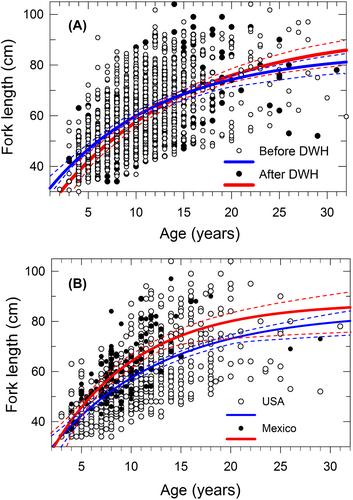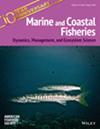Temporal and spatial patterns in population demography of Tilefish in the Gulf of Mexico
Abstract
Objective
The objectives of this study were to compare population dynamics of Tilefish Lopholatilus chamaeleonticeps before and after the 2010 Deepwater Horizon (DWH) oil spill in the north-central Gulf of Mexico (GoM) as well as inside and outside the spill area in the western and southwestern GoM (off Mexico).
Methods
Due to the availability of prespill samples of Tilefish, we were able to evaluate growth, mortality, and condition factors during two time periods (2000–2009 versus 2011–2017). Samples were derived from commercial landings and research vessel surveys using demersal longline fishing gear.
Result
Although some von Bertalanffy growth parameters differed for fish caught before and after the spill within the spill area, confidence limits for predicted growth curves overlapped for ages >10, while predicted growth for ages <10 declined somewhat after the spill. Tilefish grew faster off Mexico than in the northern GoM. Total instantaneous mortality rates (Z), estimated from aggregate multi-year catch curves, were highest off Mexico (0.39 ± 0.05 SE), lowest in the western GoM outside the spill area (0.21 ± 0.03), and similar before and after the DWH spill within the spill zone (0.32 ± 0.02).
Conclusion
Although Z on the stock within the spill area apparently did not change, differences in fishing mortality may have compensated for changes in natural mortality. Because 90% of the fish that were aged after the spill were alive prior to the spill, their accumulated growth history may have masked postspill growth changes. As we are now 14+ years past the 2010 spill, comparisons of population dynamics from samples collected now and in the future may provide a clearer picture of the strength of incoming year-classes and the long-term implications of the spill on Tilefish populations.


 求助内容:
求助内容: 应助结果提醒方式:
应助结果提醒方式:


